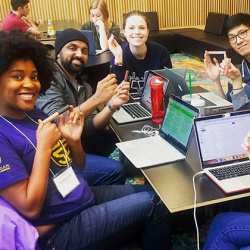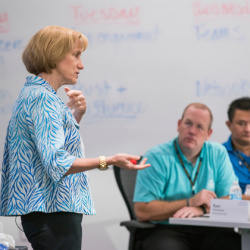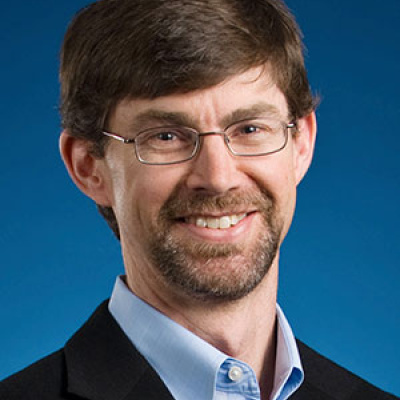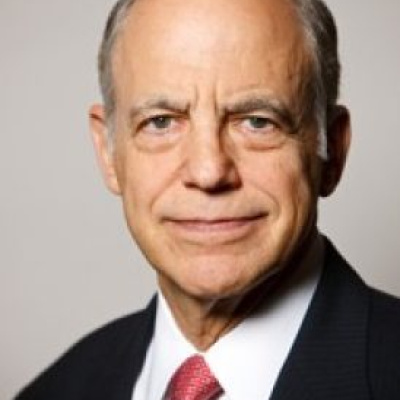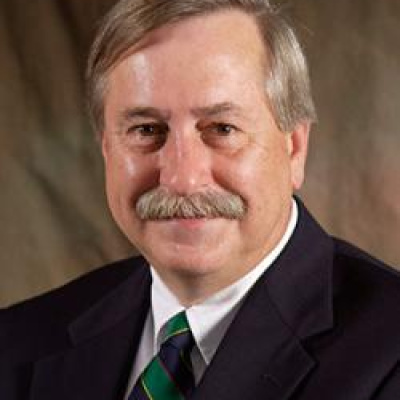Explore the faculty research, thought leadership, and groundbreaking philosophies that established Michigan Ross as one of the world’s top business schools.

The 1996 book Competing for the Future by the late Professor C.K. Prahalad and his colleague, Gary Hamel from the London Business School, was unique in that it tied together several of Hamel and Prahalad's leading ideas into book format. The book introduces the concept of "core competencies," which emphasizes that organizations should focus on leveraging their inherent strengths and unique capabilities, and "strategic intent," which focuses on setting an ambitious, long-run vision for a firm's future. This emphasis on future thinking was a particularly notable aspect of the book. In general, the book advocated for a proactive approach to strategy where businesses actively envision and shape the trajectory of their respective industries instead of merely reacting to existing competitors and market dynamics in the short run. This emphasis on dynamics -- in particular, envisioning the future and then mobilizing strategy to compete in shaping it -- had important managerial implications for business thinking in the 1990s. It suggested that companies needed to transition from a short-term, reactive mindset to a more forward-thinking, visionary stance; this would allow companies not just to survive but dominate in future market landscapes. Overall, this book had a notable impact on business practice; Time Magazine named it one of "The 25 Most Influential Business Management Books."

The article "Social Distancing as a Control Mechanism" by Professor James Westphal, is part of a larger stream of research that developed a more sociological perspective on corporate leadership and governance, an area of scholarship that had been largely dominated by economic perspectives into the 1990s. In a series of studies, Westphal and colleagues revealed a collection of social and psychological mechanisms by which governance policies, structures, and practices that were assumed to promote the economic interests of shareholders and other stakeholders were frequently subverted in ways that served the interests of powerful corporate elites. One such mechanism was "social distancing," a social sanction in which corporate directors who participated in governance reforms that threatened to increase board control over top management at one firm were socially isolated and even ostracized at other firms where they served on the board. They were less likely to be invited to informal meetings, and other directors were less likely to build on their comments and suggestions or solicit their opinions on strategic issues in formal board meetings. Directors who experienced social distancing, witnessed it firsthand, or were socially connected to a director who experienced it, were less likely to participate subsequently in elite-threatening actions. In that sense, the social distancing that Westphal identified parallels and anticipates the social distancing that we all learned about and practiced during the COVID-19 pandemic. But unlike social distancing during a pandemic, social distancing in corporate leadership, like the other social and psychological mechanisms that the authors uncovered, helped maintain a system that serves the interests of a powerful few rather than the many who depend on it for employment, goods and services, and wealth creation.

From 2000 to 2005, Professors C.K. Prahalad and M.S. Krishnan co-authored several papers on concepts related to how the emergence of digital technologies was transforming business models. From 2005 to 2008, they co-authored the book New Age of Innovation, which introduced the concept of N=1;R=G business model framework. The basic argument was that given the new capabilities emerging from digital technologies, the structure of business models was in the midst of a transformation across industries. They claimed that business models will shift from mass production of products or services to businesses co-creating personalized experiences for one customer at a time. They called this N=1 business model, i.e., businesses will operate on a sample size (N) of one. They argued that to orchestrate this personalized experience for one customer at a time, businesses will not own all resources but will connect with resource partners across the globe (Resources=Global or R=G), and these partners could be big organizations, small businesses, entrepreneurs, or even individuals. They called this business model N=1;R=G. They argued that digital technology was at the center of enabling these capabilities, and no industry will be immune to this change. They presented more than 80 examples in the book. The rest of the book was on the capabilities companies needed to build inside their organizations to compete as an N=1 business. Their primary thesis identified the significant role of software in orchestrating the personalized N=1 experience in an ecosystem of partners and the criticality of the right capabilities in the information architecture and social architecture of companies to thrive in this competition of N=1;R=G ecosystem business models.

Professor Kenneth Lieberthal was a pioneer in the practice of business school professors contributing their knowledge in public service to society. Lieberthal served as the senior director for Asia for the U.S. National Security Council during the years 1998-2000.
During that same time, Lieberthal was also special assistant to President Clinton for National Security Affairs. His core academic research findings included a seminal analysis of China's bureaucratic system, which featured a nuanced and careful delineation of the fragmented nature of China's political system in the late 20th century.
Lieberthal's research was able to explain why China, during that era, had weak policy implementation at times because of the fragmentation in its bureaucratic system. He was known for introducing U.S. policymakers to a nuanced and careful understanding of the Chinese governmental system and how it functions.

In 2021, Assistant Professor Andreas Hagemann developed a new econometric methodology that addresses the complexities of clustered data to enhance the accuracy and reliability of empirical work in economics and related fields. Typical examples of clusters are firms, cities, or states. The central challenge is that units within clusters may influence one another or may be influenced by similar environmental factors in ways that cannot be observed. Empirical researchers know that neglecting to account for clusters can yield results where non-existent effects erroneously appear as highly significant. Hagemann's research agenda developed new tools to address this issue in challenging and empirically relevant scenarios. His work has had a substantial impact on econometric theory and empirical practice. For instance, the methodology he developed is now the standard option for clustering in the canonical implementation of quantile regression in the statistical programming language R.
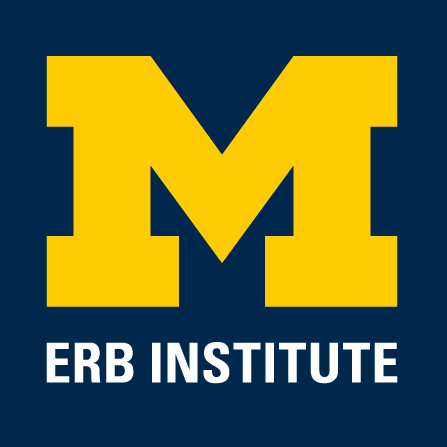
In 2018, Professor Tom Lyon led a team of scholars who published a groundbreaking article about corporate political responsibility titled “CSR Needs CPR” in the California Management Review. The article argued that corporate social responsibility was an insufficient measure of corporate contribution to society and that stakeholders who care about CSR should also pay attention to corporate political responsibility. In 2019, Elizabeth Doty, adjunct faculty at Presidio Graduate School, contacted the Erb Institute at the University of Michigan and suggested turning the article into an industry roundtable dedicated to working with a select group of influential business leaders and their companies to bring to life the core precept of the article – the need to better align companies’ political spending and lobbying with their commitments to values, purpose, sustainability, and stakeholders. Thus, the Erb Corporate Political Responsibility Taskforce was founded in 2020. Lyon and Doty have developed the taskforce into a nationally recognized forum with the goal of making CPR a new norm for business. The taskforce operates under Chatham House Rule and has 20 members from some of the most recognized brands in the United States who share best practices and address CPR challenges. In 2023, the taskforce released the non-partisan Erb Principles for Corporate Political Responsibility, with five major companies as inaugural signatories. Looking ahead, the taskforce will continue building its integrated framework and engage more companies in applying the Erb Principles. Lyon continues his work in this space with his recently published volume Corporate Political Responsibility.

Michigan Business School Professor and Erb Institute Faculty Director,Tom Gladwin, pioneered the field of business sustainability with his concept of a "science of sustainable enterprise." It was one of the first scholarly frameworks to bring together the social, environmental, economic, and organizational aspects of competitive companies that likewise are managed to explicitly create value for society. With groundbreaking publications like "Shifting Paradigms for Sustainable Development: Implications for Management Theory and Research" and "Beyond Eco-Efficiency: Towards Socially Sustainable Business" in the 1990s, Gladwin dramatically expanded the scope of traditional management education and business leadership. Throughout his career, and his long-time partnership with the Prince of Wales's Business & the Environment Programme, Gladwin influenced hundreds of CEOs and other top corporate leaders to think deeply about, and take action on, the threat and the opportunity of sustainable business.

Michigan Ross is known for being one of the first places to promote and provide rigorous evidence contrary to the efficient market hypothesis. The work of Professor Victor Bernard, a faculty member from 1982-1995, played a huge role in the beginnings of literature on market inefficiency. His work in valuation and fundamental analysis was the first to provide evidence that investors could not fully process information in earnings releases. The inefficient markets argument was further supported by the work of Professor Richard Sloan, a faculty member from 1997-2007. Bernard demonstrated that market participants treat the two basic components of accounting — cash and accruals — in an irrational way when making their valuation of corporate securities. This behavior became known as the "accrual anomaly." Bernard's work twice won the Notable Contribution to the Accounting Literature Award.

The public corporation in America is vanishing, and more people, from low-income earners to professionals, are doing their work in the so-called “gig economy.” The work of Professors Jerry Davis and Sue Ashford put these two issues on the research agenda of scholarly colleagues. Davis documents the first idea in his book, The Vanishing American Corporation (2016). Although some scholars have suggested that over-regulation might account for this surprising trend, he argues that a more fundamental shift in the economy, enabled by information and communication technologies, was ultimately responsible. By making it cheaper to "buy" rather than "make" inputs (from capital and labor to supplies, manufacturing, and distribution), information and communication technologies have made the parts of an enterprise like a pile of Legos, ready to assemble into a business, scale, and disassemble. This idea explains Nikefication, Uberization, Amazon, and other recent trends in the organization of the U.S. economy, as well as why the same technologies are used differently in different countries, resulting in very different corporate structures. If what Davis says is true, then fewer people will be working in large public corporation settings going forward. This shift may account for the growth in people working independently, some using technologically mediated apps to find and conduct work. Ashford puts the gig economy and gig workers on the agenda of people wanting to understand individuals at work. Her qualitative and quantitative studies identify the challenges faced by those working independently and what they can do to survive and thrive. Challenges include maintaining one’s identity, keeping sufficient income flowing in, staying organized, finding and maintaining work connections, and figuring out how to make working in this manner work over the long run. This research tests a variety of interventions and solicits ideas from individuals working in this manner regarding strategies that make this kind of work-life viable and enlivening.

The paper "Quantity Flexibility Contracts and Supply Chain Performance" by Professor Bill Lovejoy and his colleague, Andy Tsay from Santa Clara University, was published in Manufacturing & Service Operations Management in 1999. The paper delves into the concept of quantity flexibility in supply chain contracts and its potential to deal with demand uncertainties. This influential work formally captured the practice of “funneling” variability over time, whereby more variability is tolerated in earlier planning phases and less tolerated over time as the delivery date approaches. This paper has specifically led to further studies on the optimal design and effectiveness of supply chain contracts, enhancing the field’s understanding of tactical and strategic issues in supply chain management. Researchers have built on Tsay and Lovejoy's model to study the application of QF contracts in different industrial contexts and their interactions with various supply chain configurations. The concept and modeling presented in this paper have become a prominent part of the academic discourse on supply chain coordination, influencing subsequent studies in inventory management, order variability, and supply chain profitability. Thus, the paper's impact is significant and broad, inspiring much-needed research on flexible, cooperative strategies for supply chain optimization.

Professor Jim Walsh was elected as the 65th president of the Academy of Management in 2006, making him only the second Michigan faculty member to lead the Academy. Walsh took stock of the approximately 16,000 members who lived in more than 100 countries at the time and noted that very few of them resided on the continent of Africa. Knowing that Africa, the cradle of civilization, is home to over a billion people and more than 1,000 universities and that the continent was poised for enormous population and economic growth, he wanted to bridge the gap and reach out to the teacher-scholars on the continent. Fully aware of the terrible history of colonization, he decided to simply create space for colleagues in Africa to meet their colleagues from the rest of the world. The first step in the process was to work with others to co-found the African Academy of Management. His continued work culminated in a 2013 AOM Africa Conference, in which approximately 300 colleagues from the world over journeyed to Johannesburg to share and imagine new research and teaching ideas. Since that time, the Africa Academy of Management has hosted a number of faculty development workshops, launched the Africa Journal of Management, and held conferences across the continent. In short, Africa-centered scholarship has burgeoned. Beyond that, the Ross School was just granted affiliate member status in the Association of African Business Schools. Professor Walsh wanted to be sure that we too are a part of the emerging scholarly conversations and evolving business practices on the continent.
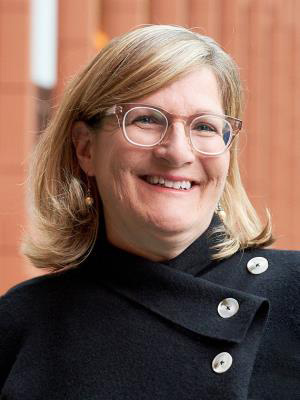
Professor Gretchen Spreitzer received her PhD from Michigan Ross in 1992. Her work on empowerment, stemming from her Michigan Ross dissertation, has set the foundation for a new understanding of the employee experience. Instead of capital that organizations needed to control, empowerment brought forth the idea that employees thrive when they are given the freedom and autonomy to do their work autonomously. This pioneering work ushered in a new era of research and a fundamental shift in how organizations view their relationship with employees.

Since an article she published in the Iowa Law Review in 1995, Professor Dana Muir has worked in the field of fiduciary obligation, particularly as it relates to the investment of the almost $37 trillion in U.S. retirement assets, but also as it relates to a variety of other employee benefit plans. In her 1995 article, Muir explained that the courts' attempts to define fiduciary obligation using concepts from fourteenth-century trust law were misguided. Muir has subsequently addressed fiduciary concepts in the context of investment advice, the extent to which employers serve as fiduciaries of the plans the sponsor, and, most recently, in their application to the consideration of environmental, societal, and governance factors in the investment of retirement fund assets.

